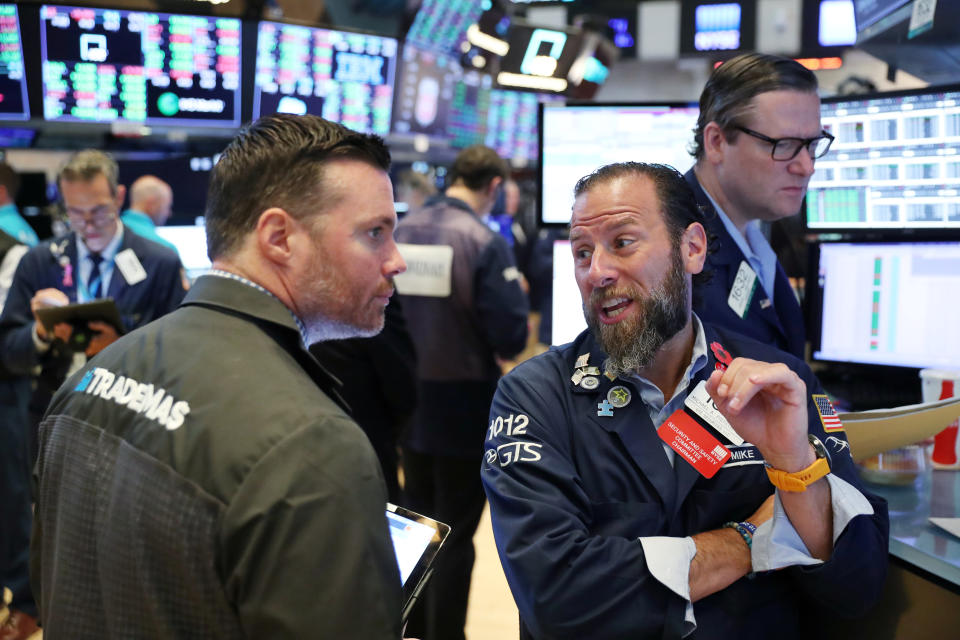Stocks slip slightly amid trade remarks, earnings season
U.S. stocks ended slightly lower Tuesday as investors digested a wave of signals from officials over U.S.-China trade relations and monetary policy, along with an influx of corporate earnings results and economic data.
The S&P 500 (^GSPC) fell 0.34%, or 10.26 points, as of market close. The Dow (^DJI) fell 0.09%, or 23.53 points, while the Nasdaq (^IXIC) fell 0.43%, or 35.39 points.
President Donald Trump said during a cabinet meeting Tuesday that the U.S. and China still had a “long way to go” in coming to a trade agreement, sending stocks initially lower after the remarks. He noted that the U.S. could still impose tariffs on an additional $325 billion worth of goods from China, underscoring to investors that trade tensions have not been fully resolved despite a truce Trump and China’s Xi Jinping agreed on after their G-20 meeting in June.
Trade tensions have been at the center of concerns for market participants and central bank officials alike, leading markets to price in with near certainty that the U.S. Federal Reserve will cut benchmark interest rates at its next meeting at the end of July as a move to preempt downside risks.
Those expectations appeared to be affirmed Tuesday, when Federal Reserve Chair Jerome Powell told a dinner audience at the Bank of France in Paris that Fed officials are “carefully monitoring” risks to the U.S. economy and “will act as appropriate to sustain the expansion.” The remarks were a recapitulation of sentiments the central bank leader had been highlighting since the Federal Open Market Committee’s June meeting.
Meanwhile, corporate earnings season began on a high note, with several major companies reporting results that beat expectations Tuesday morning. Goldman Sachs (GS), the third major bank to report earnings results this week, topped Wall Street’s expectations on the top and bottom lines as the bank’s investment and lending revenue jumped by double-digit percentages over last year. Goldman also remained strong in delivering on deals and equity offerings during its fiscal second quarter.
Peer bank Wells Fargo (WFC), which reported before-the-bell on Tuesday, also exceeded consensus expectations on the top and bottom lines, with results boosted by stronger earnings from non-interest income. JPMorgan Chase, the largest U.S. bank by assets, also beat consensus expectations for the reported quarter, but cut its forecast for closely watched net interest income for the full-year 2019. Morgan Stanley (MS) and Bank of America Corporation (BAC) will also report results later this week.
Meanwhile, health conglomerate Johnson & Johnson (JNJ) posted a more than 40% surge in quarterly net income over last year. The company topped analysts’ revenue expectations in each of its three major units – pharmaceutical, consumer goods and medical devices. However, the stock did a U-turn after initially rising, amid concerns over ongoing litigation surrounding the company’s alleged role in the opioid crisis, and allegations that its talc-based baby powder caused cancer and mesothelioma.

Only a handful of S&P 500 companies have reported earnings so far, and the results have so far mostly exceeded expectations. But hundreds of components will report over the weeks to come, including those that had guided below consensus expectations during first-quarter results.
Expectations were low heading into earnings season. Consensus forecasts were looking for an about 2% year-over-year decline in aggregate S&P 500 EPS during the second-quarter, according to a Goldman Sachs analysis. If realized, this would mark the first year-over-year decline in quarterly EPS since 2016.
ECONOMY
Advance retail sales estimates for June climbed above consensus expectations as consumers stepped up buying across segments. The gains were broad-based, with buying from internet retailers leading advances by sector with a 1.7% gain for the second straight month. Only specialist electronics and department stores registered sales declines in June.
Headline retail sales rose 0.4% in June over the month prior, versus a 0.2% gain expected, according to Bloomberg data. May’s retail sales figures were revised slightly lower to see a 0.4% gain, from 0.5% previously.
Excluding food, autos and gas sales, retail sales rose 0.7% in June, which also topped expectations for a 0.3% gain. This measure of retail sales is considered by many economists to provide a better gauge of underlying final demand, as it strips out more volatile categories.
The Commerce Department’s read on retail sales comes after Fed Chair Jerome Powell, in congressional testimony last week, underscored the continued strength of the U.S. consumer in the domestic economy.
Separately, import prices fell in June by the largest amount in six months amid falling oil prices and a softer global economy amid ongoing trade tensions. U.S. import prices fell 0.9 % in June, the Bureau of Labor Statistics reported, versus a 0.6% decline expected. This marked the first monthly decrease in the index since December. Excluding fuel prices, import prices fell 0.4% month-over-month in June, or steeper than the 0.2% decline expected.
Meanwhile, a measure of factory, mining and utility output was unchanged in June, according to the Federal Reserve Tuesday. The headline print on U.S. industrial production registered at 0.0% in June, versus an increase of 0.1% anticipated. A rise in manufacturing output and mining offset declines in utilities output in June, resulting in a flat reading for the month.
For the second quarter overall, industrial production declined at an annual rate of 1.2%, marking its second consecutive quarterly decrease.
—
Emily McCormick is a reporter for Yahoo Finance. Follow her on Twitter: @emily_mcck
Read more from Emily:
Earnings season, Amazon Prime Day – What to know in the week ahead
Tech companies like Lyft want your money – not ‘your opinion’
Follow Yahoo Finance on Twitter, Facebook, Instagram, Flipboard, LinkedIn, and reddit.
Read the latest financial and business news from Yahoo Finance

 Yahoo Finance
Yahoo Finance 